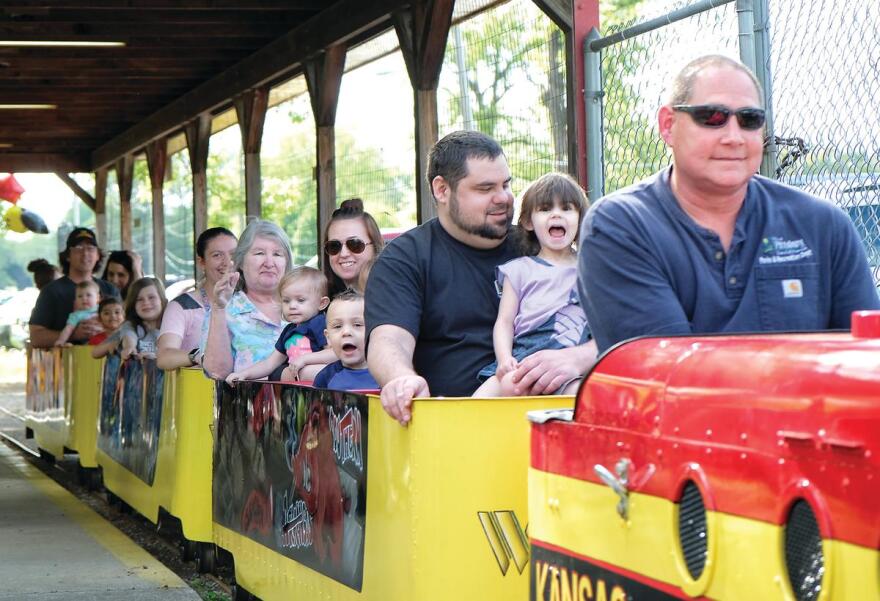This story was first published in KCUR's Adventure! newsletter. You can sign up to receive stories like this in your inbox every Tuesday.
The history of Pittsburg, Kansas, runs deep. Located in Crawford County — the Fried Chicken Capital of the World — the city started out as a mining camp.
It became “New Pittsburgh” in 1876 (named for Pittsburgh, Pennsylvania), though it dropped the “New” and the “h” somewhere along the way.
Now the southeast Kansas city is a center for academics, artists, entrepreneurs, and technology.
Pittsburg is a two hour drive from Kansas City down I-69, a relatively easy trek south along the Frontier Military Historic Byway.Crafting Crawford County

The city of Pittsburg is centered around the intersection of 4th and Broadway, where two of the original buildings are still standing.
Check out the Downtown Walking Tour, which includes over 100 locations of historic buildings, mostly along Broadway. You can also see some of the city’s latest additions: murals by local artist Jenna Spencer brightening 100-year-old brick walls.
Mining is an integral part of understanding the history of the region. When coal was discovered in the 1860s, people came to the area for jobs from all over, with immigrants from over 50 different countries. The Weir-Pittsburg coal field covered a vast area and fed over 100 mining camps.
Miners are honored at Pittsburg’s Miners Memorial Park at 2nd and Walnut, where you can partake in an audio tour about life in the mines. A half block east is Immigrants Park, honoring the many people who came to the area for the mining industry.
Just a 15 minute car drive north in Franklin, Kansas, visit the Miners Hall Museum to learn about the harsh conditions (a few miles north of Pittsburg, 44 miners—both men and boys—died in an 1888 explosion, with many others injured) and how the industry affected the area.
Because of the mining industry, Pittsburg became a place for social reform, as well, with protests over working conditions and unionization to protect the miners. A mural in the Pittsburg Public Library, “Solidarity” by Wayne Wildcat, memorializes a demonstration in 1921 that included thousands of women marching in support of striking miners.
Pittsburg celebrates its heritage with Little Balkan Days over Labor Day weekend. The festival, which runs August 28-September 3 this year, includes concerts, cooking classes, scenic train rides, crafts, a car show, photography contest, dog show, and more.
The Crawford County Historical Museum, which is free, showcases the eclectic components of local history, from mining to agriculture (with a taxidermied two-headed calf), moonshine (with a 100-year-old bathtub still) to beauty queens (the 1968 Miss America Debra Dene Barnes). The museum features quirky tableaux with manikins and artifacts, videos relating local reminiscence, a general store, a one-room schoolhouse, and an old mining steam shovel out front.
Throughout the year, the museum hosts events, including September’s Cow Creek Border Wars, now in its seventh year.Come for the chicken

If there’s one thing Pittsburg (and the whole of Crawford County) is known for, it’s their fried chicken, which has garnered international attention.
Nearly 90 years ago, a couple of women started serving up chicken dinners to make ends meet. Their husbands had been injured in the mines and the women sold meals out of their homes.
The first was Chicken Annie’s, in 1934, closely followed by Chicken Mary’s in the early 1940s. Now, those two businesses operate within 500 ft of each other out in the country, run by the third generation, surrounded by farm fields.
Those aren’t the only fried chicken places in the county, though. Gebhardt’s Chicken in Mulberry, which started in 1946, serves up chicken dinners, too, but only has noodles on Mondays (and it’s cash or check only). Chicken Annie’s of Girard, on K-47, branched off in 1971. Pichler’s Chicken Annie’s, south on Broadway, was founded by Mary’s granddaughter and Annie’s grandson, who were married in 1965.
This culinary curiosity also hatched the novel “The Chicken Sisters” by KJ Dell’Antonia, loosely based on these “rival” chicken restaurants.
Most of these restaurants are open for dinner Tuesday-Sunday, along with Sunday lunch, serving multi-generational patrons generous portions.
If you’re wanting breakfast, try Otto’s Cafe, in the converted Hotel Stilwell. For a lunch option, try the Mall Deli (it’s the deli in the Meadowbrook Mall off of Centennial Drive), a Pittsburg staple for over 40 years that serves up delicious sandwiches and is known for its creamy Italian dressing.Pitt State

As mining operations dissolved, Pittsburg State University grew. Pittsburg State University started as a teachers college in 1903 with 54 students. Now, 12 decades later, it’s an award-winning academy in southern Kansas, with a champion football team, and is the largest employer in the city.
Pitt State is home to the Gorillas — the only gorilla mascot in the U.S. (his nickname is “Gus”). You’ll find gorilla statues throughout the city, and, during warmer months, some banana trees placed around campus. (Want a replica Gus the Gorilla statue? You can purchase a 16-inch brass version for $2,500.)
Get to know the campus with the four-mile PSU Walking Trail, a loop that takes you through Gorilla Village (a park near the stadium for pre-game rituals and celebrations), Timmons Chapel, University Lake, the PSU Veterans Memorial, and the Oval.
You can also catch a show at the Bicknell Family Center for the Arts. Before you head in, find the Andy Warhol screenprint of Ludwig van Beethoven displayed in the lobby.Kidd Pitt

Even though it’s a college town, Pittsburg has a selection of family-friendly options, too.
Stop by the beautiful Prairie-style Pittsburg Public Library and visit the whimsical children’s section, decorated in an “Alice in Wonderland” motif. The theme is based on an “Alice” painting saved when the library caught fire.
(Many towns and cities, including the original Pittsburgh, have Carnegie Libraries that were built with funds from industrialist Andrew Carnegie. But Carnegie was anti-union, so Pittsburg, Kansas, declined to put his name on their building.)
Kiddieland Amusement Park has been a staple for Pittsburg’s littlest youngins for generations, located in Lincoln Park. The attraction turned 70 years old this year, with a miniature train, roller coaster, Ferris wheel, airplane rides and a carousel, all designed for children. It’s open during the warmer months, Tuesday-Saturday, and two ride tickets cost $3.
A newer addition to the kid-friendly scene is Fun Zone Depot, with bounce houses, climbing wall, and other games and activities. The facility is in a historic building that used to be a train depot, on Locust Street.
Pittsburg Parks and Recreation runs 15 parks, with a variety of activities, including pools and splash park, disc golf, band concerts, and annual events.The great outdoors

Mining changed the environment in southeastern Kansas, as minerals were extracted first through shaft pits and then through strip mining. But man’s harsh mark on the land is being converted though Mined Land Wildlife Area, where former strip pits have become ponds and lakes, the flora and fauna reclaiming the area.
Now, the pits are popular canoeing and fishing spots, run by the Kansas Department of Wildlife and Parks. Hiking, hunting, and berry picking are among the uses in the 14,000 acre area throughout southeast Kansas. Swimming is not allowed.
Wilderness Park, in Frontenac, Kansas, was donated as a land preserve. It also allows fishing, and most of the relatively short trails are ADA accessible.
Crawford County is also part of the TransAmerican Trail USBR76, a bike route that runs through the county, connecting Virginia to Oregon.Southeast side treks

There’s a fair amount of interesting side quests in southeast Kansas, if you are traveling around the area.
Fort Scott, along I-69, has a historic downtown with colorfully painted buildings and the Fort Scott National Historic Site, open sunrise to sunset. There is also the Gordon Parks Museum and the Lowell Milken Center for Unsung Heroes.
An artifact from the region’s mining heritage is Big Brutus, the world’s largest electric shovel. Located in West Mineral, Kansas, about 30-minute drive from Pittsburg, it’s a must-see for fans of Virginia Lee Burton’s 1939 classic Mike Mulligan and His Steam Shovel.
About an hour northwest of Pittsburg is Chanute, Kansas, home of the Martin and Osa Johnson Safari Museum, which details the life and travels of Kansan husband-and-wife explorer/filmmakers from the early 20th century. Admission is currently free due to sponsorship from local businesses.







